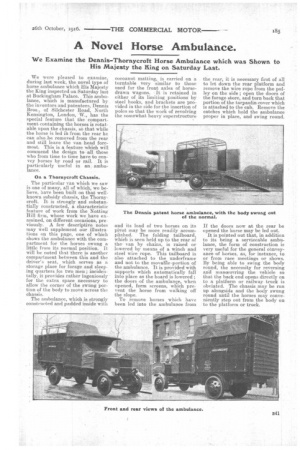A Novel Horse Ambulance.
Page 13

If you've noticed an error in this article please click here to report it so we can fix it.
We Examine the Dennis-Thornycroit Horse Ambulance which was Shown to His Majesty the King on Saturday Last.
We were pleased to examine, during last week, the novel type of horse ambulance which His Majesty the King inspected on Saturday last at Buckingham Palace. This ambulance, which is manufactured by the inventors and patentees, Dennis Bros., of Silehester Road, North Kensington, London, W., has the special feature that the compartment containing the horses is rotatable upon the chassis, so that while the horse is led ill from the rear he can also .be removed from the rear and still leave the van head foremost. This is a feature which will commend the design to all those who from time to time have to convey horses by road or rail. It is particularly useful in an ambulance.
On a Thornycroft Chassis.
The particular van which we saw is one of many, all of which, we believe, have been built on that wellknown subsidy chassis, the Thornycroft. It is strongly and substantially constructed, a characteristic feature of work from the Notting Hill firm, whose work we have examined, on different. occasions, previously. A few descriptive notes may well supplement our illustrations on this page, one of which shows the ambulance with the compartment for the horses swung a little from its normal position. It Will be noted that there is another compartment between this and the driver's seat, which serves as a storage place for forage and sleeping quarters foi two men ; incidentally, it provides rather ingeniously for the extra space necessary to allow the corner of the swung portion of the body to move across the chassis.
The ambulance, which is strongly constructed and padded inside with cocoanut matting, is carried on turntable very similar to those used for the front axles of horsedrawn wagons. It is retained in either of its limiting positions by steel hooks, and brackets are provided in the side for the insertion of poles so that the work of revolving the somewhat heavy superstructure and its load of two horses on its pivot may be more readily accomplished. The folding tailboard, which is seen held up to the rear of thevan by chains, is raised or lowered by means of a winch and steel wire rope. This tailboard is also attached to the underfrarne and not to the movable -portion of the ambulance. It is provided with supports which automatically fall into place as the board is lowered ; the doors -of the ambulance, when opened, form screens, which prevent the horse from walking off the slope. To remove horses which have been led into the arnbulaoce from the rear, it is necessary first of all to let down the rear platform and remove the wire rope from the pulley on the side ; open the doors of the forage store, and turn back that portion of the tarpaulin cover which is attached to the cab. Remove the catches which hold the ambulance proper in place, and swing round.
If the doors now at the rear he opened the horse may be led out. It is pointed out that, in addition to its being a serviceable ambulance, the form of construction is very useful for the general conveyance of horSes, as, for instance, to or from race meetings or shows. By being able to swing the body round, the necessity for reversing and manceuvring the vehicle so that the back end opens directly on to a platform or railway truck is obviated. The chassis may be run up alongside and the body swung round until the horses may conveniently step out from the body on to the platform or truck.
























